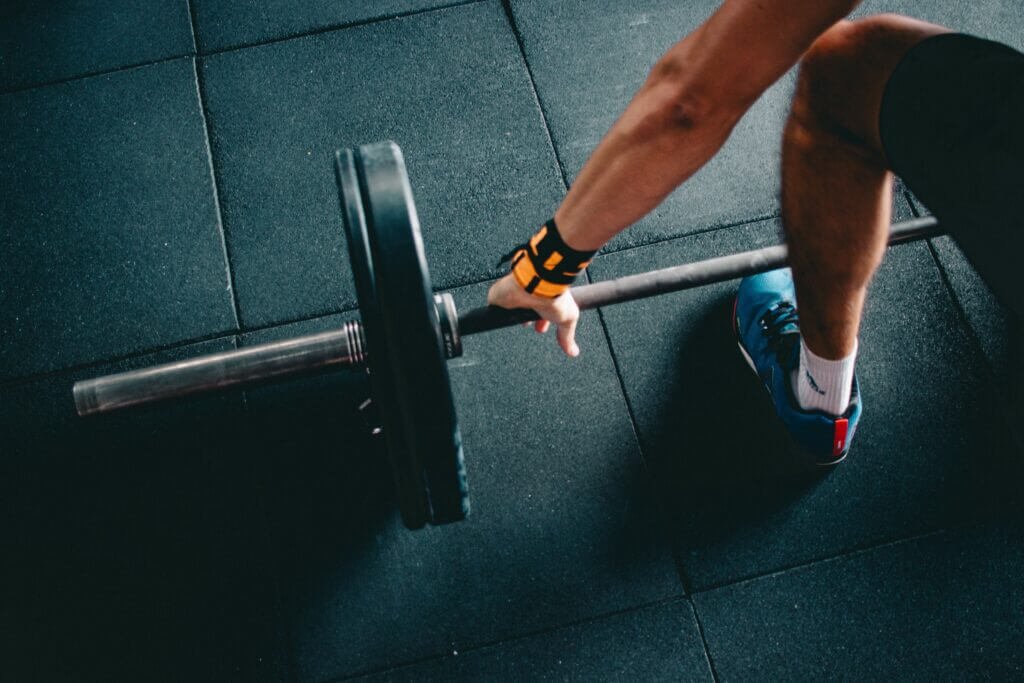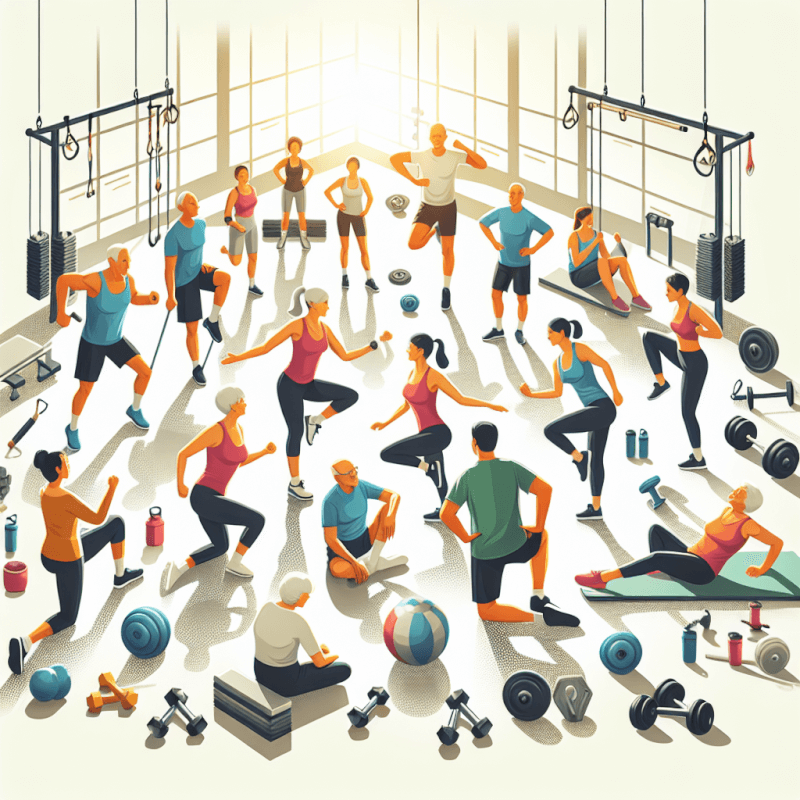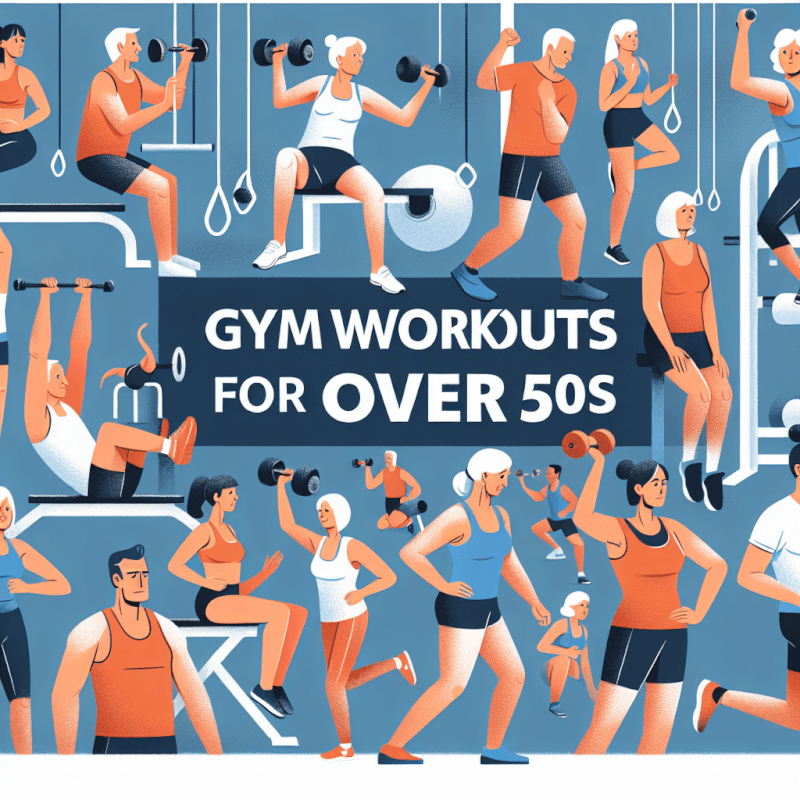If you’re over 50 and looking to stay active and healthy, gym workouts are an excellent option for you. Not only can they help improve your strength, flexibility, and overall fitness, but they also provide a great opportunity to socialize and meet like-minded individuals. In this article, we will explore some effective gym workouts specifically tailored for those over 50, ensuring that you can enjoy all the benefits of regular exercise while taking into consideration any age-related limitations or concerns. So, let’s get started and discover how you can stay fit and fabulous with these gym workouts designed just for you!

Choosing a Gym
Considerations for Over 50s
When choosing a gym, there are certain factors that are particularly important for individuals over 50. Look for a gym that caters to a diverse age range, as this indicates that they have experience and knowledge in providing appropriate workouts for different needs. Consider the gym’s atmosphere and ensure that it feels welcoming and non-intimidating. Additionally, assess the gym’s equipment to see if it is suitable for your fitness goals and needs.
Accessibility and Amenities
Another crucial aspect to consider when choosing a gym is its accessibility and amenities. Look for a gym that is conveniently located and easily accessible. Consider the parking availability and accessibility for individuals with mobility issues. Additionally, check if the gym offers amenities such as showers, lockers, and changing rooms to make your workout experience more comfortable and convenient.
Qualified Staff and Personal Trainers
Choosing a gym with qualified staff and personal trainers is essential, especially for individuals over 50. Trainers who have experience working with older adults can provide personalized guidance and support in developing a safe and effective workout routine. Look for certifications and qualifications when evaluating the gym’s staff. The expertise and knowledge of the trainers can greatly enhance your fitness journey and help you achieve your goals while minimizing the risk of injuries.
Consulting a Doctor
Importance of Medical Clearance
Before starting any new exercise program, it is important to consult a doctor, especially if you are over 50. Medical clearance ensures that your body is ready for physical activity and can help identify any underlying health concerns that may affect your workout routine. Your doctor can provide insights into the best types of exercises for your health condition and advise on any modifications or restrictions that might be necessary to ensure your safety.
Discussing Existing Conditions
During your doctor’s visit, be sure to discuss any existing health conditions you may have. Share relevant medical history, such as heart conditions, arthritis, osteoporosis, or joint issues. This information will allow your doctor to provide tailored recommendations and advice on exercises that suit your specific needs. Open and honest communication with your doctor is crucial in order to create a safe and effective workout plan.
Exercise Recommendations
Your doctor will be able to recommend exercises that are appropriate for your age, fitness level, and health condition. They may suggest a combination of cardiovascular exercises, strength training, balance exercises, and flexibility exercises. Following their recommendations will help you stay active and improve your overall health while minimizing the risk of any complications related to your existing conditions. It is important to remember that everyone’s exercise recommendations may vary, so consult with your doctor to receive personalized advice.
Warm-up and Stretching
Benefits for Over 50s
Warm-up and stretching exercises are particularly beneficial for individuals over 50. They help prepare your body for physical activity by increasing blood flow to the muscles, improving flexibility, and reducing the risk of injuries. Warm-up exercises increase your heart rate gradually and effectively warm up your muscles, making them more pliable and less susceptible to strains or sprains. Stretching exercises, on the other hand, help improve range of motion and flexibility, allowing you to move more freely during your workouts and in your daily life.
Dynamic Movements
Incorporating dynamic movements into your warm-up routine can be highly beneficial. Dynamic movements involve active stretching, such as leg swings, arm circles, and trunk rotations. These movements not only warm up your body, but they also help improve joint mobility and increase muscle activation. Dynamic movements can vary based on personal preference and targeted muscle groups.
Stretching Exercises
Stretching exercises are an important part of any workout routine, especially for individuals over 50. Static stretching, where you hold a stretch for a set amount of time, can help improve flexibility and reduce muscle tightness. Focus on stretches that target each major muscle group, including your legs, arms, back, and shoulders. Remember to stretch both sides of your body equally to maintain balance and symmetry. Hold each stretch for around 20-30 seconds and repeat 2-3 times for optimal results.
Cardiovascular Exercises
Benefits of Cardiovascular Exercise
Cardiovascular exercise, also known as cardio or aerobic exercise, offers a wide range of benefits for individuals over 50. It strengthens your heart and lungs, improves circulation, and helps control weight. Regular cardiovascular exercise can also help reduce the risk of chronic diseases, such as heart disease, high blood pressure, and diabetes. Engaging in cardiovascular exercise increases endurance, improves mood, and boosts overall energy levels.
Low-Impact Options
For individuals over 50, low-impact cardiovascular exercises are often recommended to minimize stress on the joints and reduce the risk of injuries. Walking is an excellent low-impact option that can easily be incorporated into your daily routine. Swimming, stationary biking, and using an elliptical machine are also great alternatives that provide cardiovascular benefits without putting excessive strain on your joints. Choose activities that you enjoy and that are accessible to you.
Interval Training
Interval training is an effective way to improve cardiovascular fitness for individuals over 50. It involves alternating between periods of intense exercise and short recovery periods. This type of training not only challenges your cardiovascular system but also improves endurance. Examples of interval training include alternating between walking and jogging, cycling at varying intensities, or using a rowing machine with bursts of higher intensity.

Strength Training
Importance for Over 50s
Strength training is essential for individuals over 50 as it helps maintain and increase muscle mass, improve bone density, and enhance overall functional fitness. Engaging in regular strength training can reduce the risk of age-related muscle loss, also known as sarcopenia. It also improves balance, stability, and posture, making daily activities easier and more enjoyable. Strength training is a key component in maintaining independence and a healthy lifestyle as you age.
Safe and Effective Techniques
When engaging in strength training, it is important to use safe and effective techniques, especially for individuals over 50. Start with lighter weights or resistance bands and gradually increase the intensity as your strength improves. Focus on proper form and technique to prevent injuries. If you are new to strength training or unsure about proper form, consider working with a qualified personal trainer who can guide you in developing a safe and effective routine.
Focus on Functional Movements
Incorporating functional movements into your strength training routine is particularly beneficial for individuals over 50. Functional movements mimic activities you do in your daily life, such as squatting, pushing, pulling, and bending. By focusing on these movements, you can improve your ability to perform daily tasks with ease and reduce the risk of injuries. Examples of functional exercises include squats, lunges, push-ups, rows, and planks.
Balance and Flexibility
Preventing Falls and Injuries
Balance exercises are crucial for individuals over 50 as they help prevent falls and injuries. As we age, balance naturally declines, but regular balance exercises can help maintain and improve balance skills. Good balance is essential for performing everyday activities and reducing the risk of falls that can result in serious injuries. Incorporating balance exercises into your routine can greatly enhance your overall stability and confidence.
Exercises for Balance Improvement
There are various exercises that can help improve balance for individuals over 50. Standing on one leg, heel-to-toe walk, and the yoga tree pose are all great options to challenge and strengthen your balance skills. Tai Chi is another excellent activity that focuses on balance, coordination, and mindfulness. Start with simple exercises and progress to more challenging ones as your balance improves. Consistency is key in order to see noticeable improvements.
Enhancing Flexibility
Flexibility exercises are important for individuals over 50 as they help maintain joint mobility and reduce the risk of muscle imbalances. Stretching exercises, such as yoga or Pilates, can help improve overall flexibility. These activities combine stretching, balance, and strength exercises to enhance flexibility and promote relaxation. Incorporating regular flexibility exercises into your routine can help prevent stiffness, promote better posture, and increase your range of motion.

Circuit Training
Benefits of Circuit Training
Circuit training is a highly effective workout option for individuals over 50. It combines cardiovascular exercise with strength training, providing a total body workout in a shorter amount of time. Circuit training helps improve cardiovascular fitness, builds muscular strength, and burns calories. It also offers the flexibility to customize the exercises based on your fitness level and goals, making it suitable for individuals of all ages.
Combining Cardio and Strength Training
In a circuit training session, you perform a series of exercises in quick succession, targeting different muscle groups. By incorporating both cardiovascular exercise and strength training into the circuit, you achieve a well-rounded workout that challenges your body in various ways. The combination of exercises provides a time-efficient means to boost overall fitness and achieve both fat loss and muscle toning.
Adapting Circuit Training
Circuit training can be easily adapted to suit your fitness level and specific goals. Choose exercises that target different muscle groups and alternate between cardio and strength-based exercises. Adjust the duration or intensity of each exercise based on your abilities and gradually increase the difficulty level as you become fitter and stronger. Don’t be afraid to modify or substitute exercises if needed to accommodate any limitations or health concerns.
Functional Fitness
Applying Exercise to Daily Life
Functional fitness focuses on exercises that mimic movements used in daily life. It is particularly important for individuals over 50 to maintain functional fitness to support their day-to-day activities. By incorporating exercises that replicate the movements you regularly perform, such as lifting groceries, getting up from a chair, or reaching for items on high shelves, you can enhance your overall strength, mobility, and flexibility in a way that directly benefits your everyday life.
Exercises for Daily Activities
To improve functional fitness, incorporate exercises that directly align with the movements you encounter in your daily activities. Examples include squats to improve the ability to get up from a seated position, lunges to mimic the motion of climbing stairs, and resistance band exercises for strengthening the muscles involved in lifting and carrying. The aim is to make your workouts more practical and applicable to your daily life, allowing you to move with ease and confidence.
Improving Quality of Life
Improving functional fitness not only enhances your ability to perform everyday activities but can also greatly improve your overall quality of life. By incorporating exercises that build strength, balance, and flexibility, you can maintain independence, reduce the risk of injuries, and enjoy an active lifestyle. Additionally, enhancing functional fitness can increase energy levels, boost mood, and promote a positive outlook on life. Invest in exercises that benefit you beyond the gym and help you live your best life.

Group Exercise Classes
Benefits of Group Exercise
Group exercise classes offer numerous benefits for individuals over 50. They provide a supportive and motivating environment, making your workouts enjoyable and fun. Group classes often incorporate a variety of exercises, ensuring a well-rounded workout that targets various fitness components. Group exercise also fosters a sense of community, allowing you to socialize with like-minded individuals and make new friends who share similar health and fitness goals.
Options Suitable for Over 50s
Many gyms offer group exercise classes specifically designed for individuals over 50. These classes focus on low-impact exercises, flexibility, balance, and strength training that cater to the unique needs of older adults. Classes such as yoga, Pilates, water aerobics, and dance-based workouts are popular choices that provide a safe and enjoyable experience. Consult with the gym staff to find out which classes are available and suitable for your fitness level.
Socializing and Motivation
One of the key advantages of joining a group exercise class is the social aspect. Exercising with others can provide a sense of camaraderie and support, making your fitness journey more enjoyable and sustainable. Building connections and friendships with fellow class participants can offer valuable motivation and accountability, keeping you committed to your workout routine. Group exercise classes create an environment of positivity and encouragement, boosting your overall enthusiasm for exercise.
Recovery and Rest
Importance of Rest Days
Rest days are an essential component of any workout routine, especially for individuals over 50. They allow your body time to recover and repair from the physical stress of exercise. Rest days play a crucial role in preventing overuse injuries, muscle fatigue, and burnout. It is important to listen to your body and not push yourself too hard. Aim for at least one or two rest days per week to give your body the time it needs to recharge and come back stronger.
Stretching and Foam Rolling
On rest days, incorporating stretching and foam rolling into your routine can help alleviate muscle soreness and improve recovery. Stretching exercises help lengthen your muscles and improve flexibility, while foam rolling releases muscle tension and improves blood circulation. Spend time stretching major muscle groups and use a foam roller to target any areas of tightness or discomfort. This combination can enhance recovery and prepare your body for future workouts.
Incorporating Restorative Activities
Rest days can also be an opportunity to engage in restorative activities that promote relaxation and mental well-being. Activities such as yoga, meditation, or gentle stretching can help reduce stress, enhance sleep quality, and improve overall mental health. Restorative activities allow you to focus on self-care and create a balanced approach to your fitness journey. Listen to your body’s needs and find activities that provide both physical and mental restoration.
In conclusion, choosing a gym that caters to the needs of individuals over 50 is crucial for a safe and effective workout experience. Consulting a doctor before starting any new exercise program is essential to assess your health condition and receive personalized recommendations. Incorporating warm-up, stretching, cardiovascular exercises, strength training, balance and flexibility exercises, and functional fitness into your routine can greatly improve your overall health and well-being. Group exercise classes offer the benefits of socializing and motivation, while rest days and restorative activities ensure proper recovery and prevent overexertion. By considering these factors and following a well-rounded exercise plan, individuals over 50 can enjoy the numerous physical and mental benefits of regular gym workouts.



